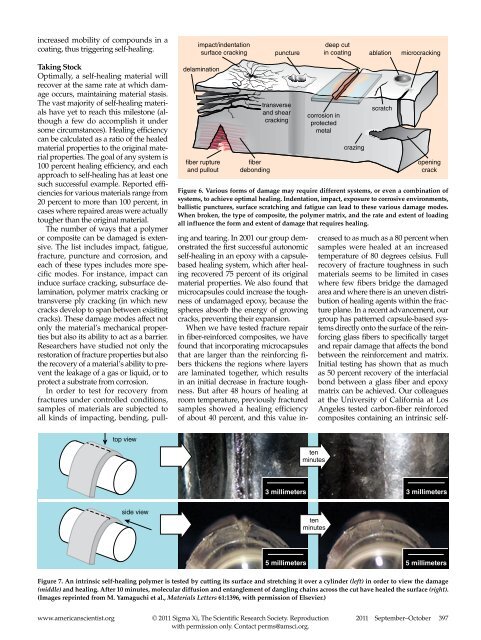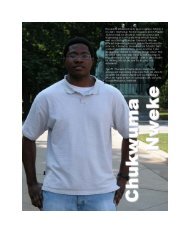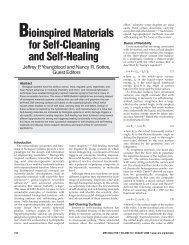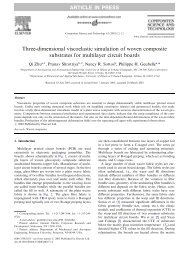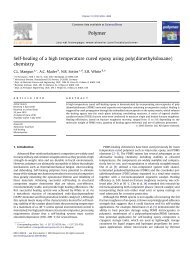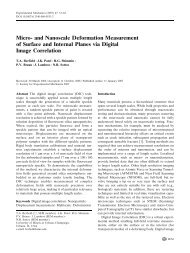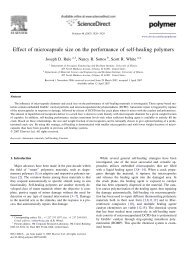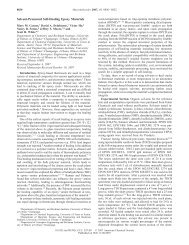increased mobility of compounds in acoating, thus triggering self-<strong>healing</strong>.impact/indentationsurface crackingcreased to as much as a 80 percent whensamples were healed at an increasedtemperature of 80 degrees celsius. Fullrecovery of fracture toughness in suchmaterials seems to be limited in caseswhere few fibers bridge the damagedarea <strong>and</strong> where there is an uneven distributionof <strong>healing</strong> agents within the fractureplane. In a recent advancement, ourgroup has patterned capsule-based systemsdirectly onto the surface of the reinforcingglass fibers to specifically target<strong>and</strong> repair damage that affects the bondbetween the reinforcement <strong>and</strong> matrix.Initial testing has shown that as muchas 50 percent recovery of the interfacialbond between a glass fiber <strong>and</strong> epoxymatrix can be achieved. Our colleaguesat the University of California at LosAngeles tested carbon-fiber reinforcedcomposites containing an intrinsic selfdelaminationfiber rupture<strong>and</strong> pulloutfiberdebondingpuncturetransverse<strong>and</strong> shearcrackingdeep cutin coatingcorrosion inprotectedmetalcrazingablationscratchmicrocrackingopeningcrackFigure 6. Various forms of damage may require different systems, or even a combination ofsystems, to achieve optimal <strong>healing</strong>. Indentation, impact, exposure to corrosive environments,ballistic punctures, surface scratching <strong>and</strong> fatigue can lead to these various damage modes.When broken, the type of composite, the polymer matrix, <strong>and</strong> the rate <strong>and</strong> extent of loadingall influence the form <strong>and</strong> extent of damage that requires <strong>healing</strong>.Taking StockOptimally, a self-<strong>healing</strong> material willrecover at the same rate at which damageoccurs, maintaining material stasis.The vast majority of self-<strong>healing</strong> materialshave yet to reach this milestone (althougha few do accomplish it undersome circumstances). Healing efficiencycan be calculated as a ratio of the healedmaterial properties to the original materialproperties. The goal of any system is100 percent <strong>healing</strong> efficiency, <strong>and</strong> eachapproach to self-<strong>healing</strong> has at least onesuch successful example. Reported efficienciesfor various materials range from20 percent to more than 100 percent, incases where repaired areas were actuallytougher than the original material.The number of ways that a polymeror composite can be damaged is extensive.The list includes impact, fatigue,fracture, puncture <strong>and</strong> corrosion, <strong>and</strong>each of these types includes more specificmodes. For instance, impact caninduce surface cracking, subsurface delamination,polymer matrix cracking ortransverse ply cracking (in which newcracks develop to span between existingcracks). These damage modes affect notonly the material’s mechanical propertiesbut also its ability to act as a barrier.<strong>Research</strong>ers have studied not only therestoration of fracture properties but alsothe recovery of a material’s ability to preventthe leakage of a gas or liquid, or toprotect a substrate from corrosion.In order to test for recovery fromfractures under controlled conditions,samples of materials are subjected toall kinds of impacting, bending, pulling<strong>and</strong> tearing. In 2001 our group demonstratedthe first successful autonomicself-<strong>healing</strong> in an epoxy with a capsulebased<strong>healing</strong> system, which after <strong>healing</strong>recovered 75 percent of its originalmaterial properties. We also found thatmicrocapsules could increase the toughnessof undamaged epoxy, because thespheres absorb the energy of growingcracks, preventing their expansion.When we have tested fracture repairin fiber-reinforced composites, we havefound that incorporating microcapsulesthat are larger than the reinforcing fibersthickens the regions where layersare laminated together, which resultsin an initial decrease in fracture toughness.But after 48 hours of <strong>healing</strong> atroom temperature, previously fracturedsamples showed a <strong>healing</strong> efficiencyof about 40 percent, <strong>and</strong> this value in-top viewtenminutes3 millimeters3 millimetersside viewtenminutes5 millimeters 5 millimetersFigure 7. An intrinsic self-<strong>healing</strong> polymer is tested by cutting its surface <strong>and</strong> stretching it over a cylinder (left) in order to view the damage(middle) <strong>and</strong> <strong>healing</strong>. After 10 minutes, molecular diffusion <strong>and</strong> entanglement of dangling chains across the cut have healed the surface (right).(Images reprinted from M. Yamaguchi et al., Materials Letters 61:1396, with permission of Elsevier.)www.americanscientist.org© 2011 Sigma Xi, The Scientific <strong>Research</strong> Society. Reproductionwith permission only. Contact perms@amsci.org.2011 September–October 397
aballistic puncture ofionomeric polymer<strong>healing</strong> matrix capable of thermallyreversible reactions; they found thatthere was a 90 percent recovery for three<strong>healing</strong> cycles when microcracks theyinduced in the material were heated to150 degrees for one minute.Another test of self-<strong>healing</strong> fractures isto physically cut the surface of a polymersample <strong>and</strong> then optically evaluate boththe scratch damage <strong>and</strong> crack closure.In several studies, polymers with intrinsicself-<strong>healing</strong> systems were cut witha razor blade <strong>and</strong> healed by realigningthe pieces for 10 to 15 minutes at roomtemperature. The repaired samples werebent or deformed to check for reopeningccapsule-based anticorrosion1 220millimeters3 450micrometersdelamination <strong>and</strong> matrixcracking in glass FRCFigure 8. <strong>Self</strong>-<strong>healing</strong> materials are of particular interest for the recovery of barrier properties<strong>and</strong> enhanced corrosion resistance. When a projectile punctures a polymer that has an ionomericintrinsic self-<strong>healing</strong> system (a), the polymer, melted by the ballistic heat, elastically snaps backinto place; viscous flow <strong>and</strong> interdiffusion of the molten surfaces seal the remaining cracks. Aglass-fiber-reinforced composite (FRC) is damaged by indentation (b); cracks in cross section ofa control sample (top) are reduced via <strong>healing</strong> in a sample with a capsule-based system (bottom).Steel coated with an epoxy (c) is scratched <strong>and</strong> then examined both optically (top) <strong>and</strong> in scanningelectron micrographs (bottom), showing corrosion in a control sample (1 <strong>and</strong> 3) <strong>and</strong> improvedcorrosion resistance in a self-<strong>healing</strong> sample (2 <strong>and</strong> 4). (Images in b reprinted from J. L. Moll et al.,Journal of Composite Materials 44:2573, with permission of Sage Publications. Images in c reprintedfrom S. H. Cho et al., Advanced Materials 21:645, with permission from John Wiley <strong>and</strong> Sons.)b1 millimeter20millimeters50micrometersof the crack faces. Some samples wereweaker than their undamaged counterparts,but many showed no breaks in thehealed areas. Some of the same studiesexamined samples that were torn insteadof cut, with similar results.Fatigue is a common mode of failurein structural materials, <strong>and</strong> it presentsunique challenges when designingself-<strong>healing</strong> materials. The load a materialexperiences from fatigue dependson an array of variables, including thefrequency <strong>and</strong> amplitude of the appliedstress. To date, only a few studies of self<strong>healing</strong>systems have looked at fatiguedamage. Our group <strong>and</strong> others haveinvestigated the relationship betweenthe damage rate, the <strong>healing</strong> rate <strong>and</strong>material life extension in these systems.When the damage rate is faster than the<strong>healing</strong> rate, damage accumulates <strong>and</strong>the material eventually fails. To counteractthis result, faster chemistries or longerrest periods for the material may berequired. However, when the damagerate <strong>and</strong> <strong>healing</strong> rate are balanced, significantlife extension has been shown.Impacts can also produce massivedamage volume, <strong>and</strong> can take on variousmodes of failure, such as puncture,delamination or mixed-mode cracking.So far, the focus of testing has been onquantifying the restoration of compressionstrength after low-velocity impact.Our colleagues at the University of Bristolhave tested carbon-fiber reinforcedepoxy with a hollow-glass-fiber networksfilled with <strong>healing</strong> agent, whichwas subjected to a range of impact energiesup to 3 joules. They found that thehollow-fiber system absorbs significantenergy as it fractures on impact, increasingcompression strength by 13 percent.Elevated temperatures allowed significant<strong>healing</strong> of the damage, but thestudy also demonstrated the material’ssensitivity to the uniformity of the channelsdistributed within the laminate.Studies of impact damage on capsulebased<strong>healing</strong> have shown mixed results.Our colleagues at ZhongshanUniversity in China tested woven-glassfiber-reinforced composites containing<strong>healing</strong> capsules. At impact energiesranging from 1.5 to 3.5 joules, they foundclose to 100 percent <strong>healing</strong> efficienciesfor the 1.5-joule impacts, but only about20 percent efficiency for the 3.5-joule impacts.However, when our group testeda similar material at impact energies of13 to 45 joules, despite extensive crackingof the sample, <strong>healing</strong> efficiency wasfound to be nearly 100 percent for impactsup to 20 joules; this efficiency decreasedas the damage volume increasedat higher impact energies.Testing with a milder form of impact,indentation, can lead to more controlleddamage. The group at the University ofBristol has used this method extensivelyon epoxy composites with hollow glassfibers to assess the release <strong>and</strong> transportof <strong>healing</strong> agents, mechanical performance<strong>and</strong> environmental aging.Besides bulk samples, our group hasalso tested the self-<strong>healing</strong> ability ofpolymer samples, such as thin bladdersor composite s<strong>and</strong>wich panels, to act asbarriers to gas <strong>and</strong> fluid flow. For ex-398 American Scientist, Volume 99 © 2011 Sigma Xi, The Scientific <strong>Research</strong> Society. Reproductionwith permission only. Contact perms@amsci.org.


